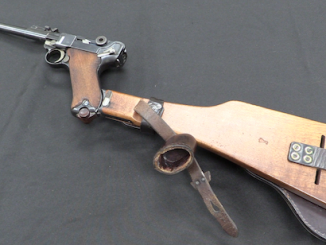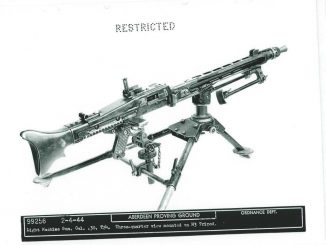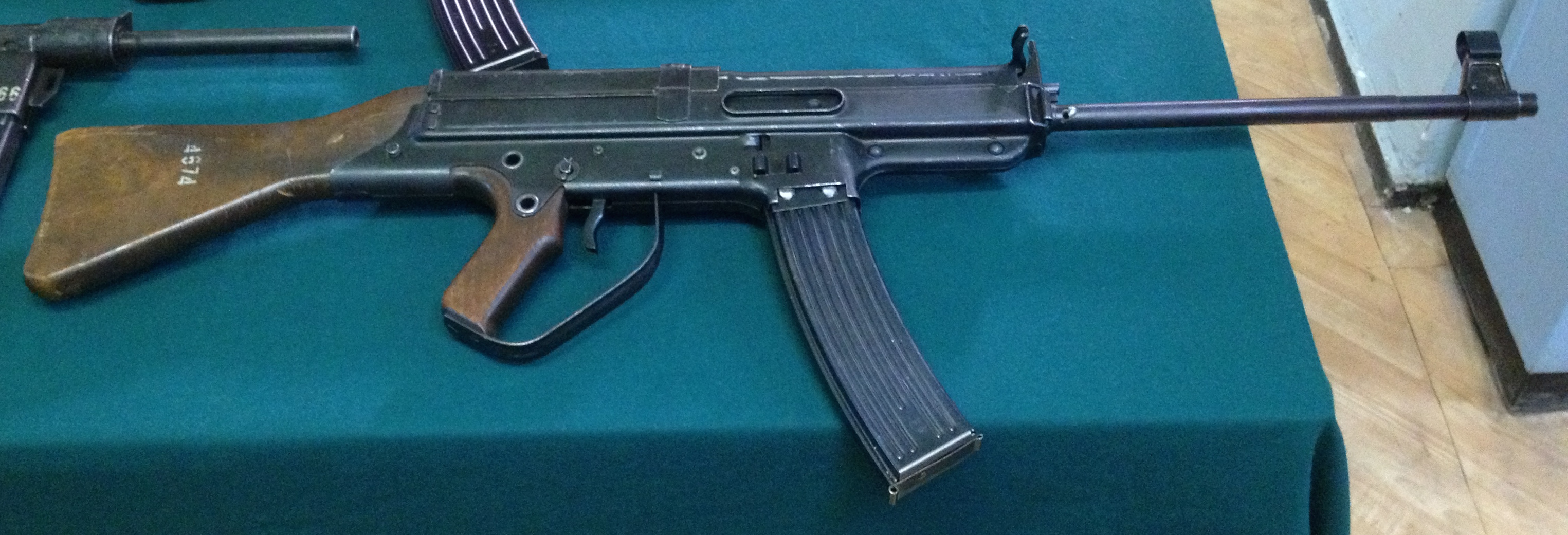In 1917, the German military issued a contract for the construction of 2500 of these unique and impressive 4-barreled flare launchers. They were manufactured by 7 different companies (this example being from Gebrüder Rempt), and were intended for the illumination of airfields. To this end, they did not just hold four 25mm flares, but actually used detachable barrel clusters (clips? magazines? The terminology does not apply well in this case…), with 8 such units being provided with each launcher. This would allow the launcher to maintain a high volume of fire; important if a large area needed to be kept illuminated. These launchers are quite scarce today, with the fewer than 2 dozen known surviving examples.
Related Articles

Semiauto pistol
Sturmtruppen Firepower: The Artillery Luger
This is lot #3569 in the upcoming RIA Premier Auction. It was scheduled for April, but has been postponed – check their web site for upcoming Online Only auctions every month, though! The lP08 (Lange […]

Commentary
An American .30-06 MG-42, and GPMGs after WWII
The perk for $100 Patrons is choosing a gun they would like me to find and film, and one such Patron (Mark) expressed a curiosity about US testing and lack of adoption of an MG-42 […]

Prototype
StG-45 Horn Prototypes
Herr Horn (I have seen his name given as both N.V. Horn and V.G. Horn; not sure which is correct) was an engineer working in the R&D department of Mauser at the end of WWII, and […]

A disposable flare tube cluster? Sounds awfully like the reload for a modern cartridge-loaded pepper blaster made by Kimber or that for a surface-to-air missile launcher, where the tube is tossed but the launching interface is kept for the next missile. I remember that Germany also made a multiple barrel heavy flare gun which operated like a Gatling. The device was nicknamed the “flaming onion.”
Did I mess up?
Another consideration is that these types of launchers may not have been used so much for illumination, but for signaling using different colors of flares – green might mean “go ahead and take off”, or “go ahead and land” etc. This was pre radio, and for communication with a pilot half a mile away, a visual indicator such as a flare might be the only way to communicate (especially in fog or darkness, when flags and so forth might not be visible).
Single barrel versions of this idea were well known as early as the Civil War, the difference being that nothing was launched from the tube. When fired, a colored flame would spray from the muzzle, which was presumably held as high up as possible for best visibility.
Perhaps the 4-tube cluster made it easier to change colors quickly.
The Civil War era “composition lights and their “pistols” were never popular with signalmen. First of all, they had to be held almost straight up over your head to be visible, and so you got showered with sparks and bits of burning composition; imagine that down the back of our shirt.
And second, they made the signalman holding the gadget a highly conspicuous target for enemy snipers.
The whole point of the later Very pistol and its high-altitude flares was to avoid both these problems. Especially by allowing the signaler to act sensibly, i.e., fire the darned thing from behind cover and duck.
cheers
eon
All true – good points
CG
ATC signalling airplanes with different-coloured flares is the best explanation so far. Modern ATC always keep an Aldis-like lamps handy in case a radio quits.
Perhaps the Gebruder flare gun was meant to be fired by aircrew in the event they were forced to land away from an airfield. Those 4-round magazines/clips …… would make it much easier to load in mid-air. Consider that many WW2 airplanes had flare launchers installed in their act fuselages. As late as the 1950s, Cessna installed flare tubes in 310 light twins.
“Fly an inspection pass over the runway at 1,000′. A second pass to drop flares. Land after the second pass. Spend the rest of the night stomping out forest fires.”
Hah!
Hah!
The problem with signalling is that the flare gun fires in a preset pattern. Say you’ve fired two green and a problem crops up. You would have to change out the mag/clip to another full clip of another signal color. Then if you reinstall the original (green) clip you would have an unfired round in it. You would need to keep quite a few mag/clips available for all possibilities. Much easier to use single shot for signalling.
Good points, but please consider the following:
1) It isn’t like you have 20 colors. Red, Green and White/Yellow, along with maybe a Purple/Blue were about the limits of the chemistry of the time.
2) How many changes can you expect with aircraft on final approach, less than 15 or maybe 30 seconds to touchdown, which would require a sudden change in flare color? Barring a tractor or herd of cattle occupying the runway (which I would presume would be fairly obvious long before any arrivals), I would speculate that the ten or so seconds to switch to a (say) red flare would allow a pilot to go around.
3) So what if an unfired round (or two, or three) remain in the four barreled cluster? The point is to communicate with the pilot, helmsman, whatever, right now. Deal with the potentially wasted five cent unfired round later. They are much cheaper than aircraft or ships, and I would speculate that bringing an expensive aircraft, and even more expensive pilot in safely would be a fair tradeoff for maybe four bits worth of flares.
CG
Good points, man. One must consider priorities in the long term, not just penny-savings. If one fires a series of signal flares to send a message as opposed to a single flare, things would be different…
The magazine seems like an adaptation of some of the short barreled harmonica guns.
Instead of random guesssing perhaps research would be a better route.
I concur. If Ian says that it was made for illumination, there must be at least one reliable source that says so. Even if it would make more sense to us if it was intended for launching signal flares, that does not mean that it was actually used for that. History of archeology is full of cases where an object was at first assumed to be meant for something or used in a certain way, based on the appearance and general background information, only to be proven wrong as a written source or additional archaeological information was found.
This isn’t random guessing. As a licensed pilot, with three degrees in chemistry, I actually have an informed opinion about:
1) Signalling to aircraft
2) How much light can be generated by what is basically a one ounce projectile, expended at (maybe) 300 feet per second, for a grand total of perhaps five seconds.
Great for signalling (especially when you can repeat for a total of four shots, in case the pilot didn’t see the first one). Impossible – yes, impossible – for adequate illumination for an aircraft that needs several minutes to negotiate it’s approach for (say) a landing.
This is exactly why star shells and other legitimate illumination devices were, and are, fired from artillery, not one inch tubes. It simply isn’t enough to illuminate an airfield for long enough, or bright enough, to do any good. Signalling, yes. Illumination, very doubtful. You simply can’t pack enough candlepower into a one inch projectile to light up even a small airfield.
CG
This is more of a question about random speculating. If the flare gun was mounted a couple hundred meters before the runway and all four flares were fired in rapid succession but at slightly different angles, somewhat like approach lights, would this be considered illuminating or signalling?
Signalling, I would think. Remember, one would have to illuminate 2000 feet or more of runway, for several minutes (WWI planes generally had pretty slow approach and takeoff speeds compared to more modern ones). You would need a whole gang of folks launching hundreds of flares to illuminate a runway like that.
Also, consider this: The last thing a pilot wants at night is a dazzling, night vision ruining fireworks display. Even modern small airports today use relatively dim lights to mark the runway, taxiways, and visual approach slope indicator at night. I do not know, but suspect, that small lanterns or fires may have been used to display the runway in these days, on those infrequent occasions when night operations were undertaken.
CG
I don’t fly, but getting to where you want to be to land seems important. There isn’t a whole lot of power in these flares, so full scale illuminating seems out of the question, but briefly illuminating the approach as a signal would seem useful. A vehicle with lights on would seem to be a better way to show the runway.
Exactly. Also, most air operations in WWI were for the purposes of observation (artillery or otherwise), or fighter support of other aircraft, of which the vast majority was done during the day, because at night there is little to see. Planes back then didn’t even have landing lights, or navigation lights, and airfields were more like (somewhat) flat fields than runways.
Having more than once been within spitting distance of an airport without being able to instantly pick it out from the air, the value of a couple of flares to help get me pointed in the right direction is not just a theoretical concept. All it would take in a wartime environment would be a crashed plane blocking the runway (perhaps not visible from the air in other than perfect daylight conditions) to require signalling for all other aircraft to either go around or divert to a previously designated secondary airfield.
It should speak volumes that every one of Manfred von Richtofen’s victories (~ 80 confirmed, more than that probable) had one thing in common – all were achieved during the day.
Is it an NFA destructive device? because of its over .50″ bore with out a sporting purpose.
Only if the barrel is rifled. If it’s smooth no problem and usually not considered a “Destructive Device” besides it is nothing more than a flare projector and would be considered a “non firearm” under the current federal firearm laws.
In WWI the only nighttime air operations I am certain of are the strategic bombing of Britain by airship and heavy bomber. If the Gotha bomber had a wireless then a multibarrel, direction finding, flare gun makes some sense.
I know of no stories of night flying anywhere else. Has anyone else come across instances?
On the other hand, having a multibarreled signalling flare gun makes more sense for more applications. There are WWII films about the RAF showing the start of a squadron’s takeout being signalled by a flaregun. If you had many unit’s taking off from the same filed (as the Germans must have done after 1915) then a multibarrel flaregun make sense. The dispatcher has the flaregun. He fires it for the first unit; counts them out; then fires for the second &c. If he had to reload there is a good chance he’d miscount on a day when it really mattered.
Yes, there were limited night flying activities done by both sides during WW1, mostly during the last year or so. Several books written by pilots of Allied pursuit planes mention the difficulties they encountered in trying to shoot down German bombers that flew virtually unopposed due to night flight conditions.
Lighting landing fields was difficult. None of the aircraft had instrument lights normally. Finding your opponent was a chore. Sudden fog was a killer. AAA fire was useless if they couldn’t see what to aim at.
One of the drivers for this activity was to be able to hit observation balloons at dusk or dawn, which required flying in the dark to start or end your mission. This was attempted due to the aircraft being safer when ground defenses couldn’t see you stalking the gas bag. Once you were close enough to shoot, so could they, unfortunately.
The war ended too soon for much in the way of techniques or technology to help, and virtually none was done in the interwar years to address this lack. So, they started all over again in WW2.
Oh, btw, Lt Frank Luke won his Medal of Honor, mostly for balloon busting, doing it this way. Still extremely hazardous though, as the balloons were highly prized by both sides for intelligence gathering. Very difficult to destroy, they had machine guns on the balloon, in addition to lots of guns surrounding them. It could take multiple passes to flame them, and most pilots hated to deal with them, as they were much more dangerous than other aircraft. They counted as a kill, same as an airplane.
Forgot to clarify, the Germans flew small bombers over the lines in France, in addition to the Gothas and dirigibles that bombed England. Same basic problems in both areas. Fighters were not very effective at night, in either location. Few pilots would attempt it, and effectiveness varied primarily due to pilot ability. It was almost entirely a pilot initiative to attempt night pursuit, and to attempt to figure out how to do it.
Excellent article on Frank Luke and shooting down WWI airships:
https://www.damninteresting.com/the-arizona-dragonslayer/
John Slessor (Later Air Marshall Sir) flew the RAF’s first night fighter sortie in 1916. When coming in to land, a searchlight unit decided to “help him out” and blinded him. After considerable discussion, both aircraft and pilot were deemed repairable. One of his pilots, William Leefe Robinson, scored the first British night fighter kill (maybe the world’s first)
https://en.wikipedia.org/wiki/Leefe_Robinson
Slessot was not present, being on leave to get married – something he called “more hazardous than night flying”
Apparently the “illumination” purpose was gleaned from the book “German Flare Pistols and Signal Ammunition” by Dr Lorenz Scheit. Anybody wanna buy it to check?
If you really needed illumination, get bigger flares!! I’m pretty sure the 37 mm heavy Gatling-style flare launchers were more than enough for the job unless you were launching flares on the attack!
John Slessor (Later Air Marshall Sir) flew the RAF’s first night fighter sortie in 1916. When coming in to land, a searchlight unit decided to “help him out” and blinded him. After considerable discussion, both aircraft and pilot were deemed repairable. One of his pilots, William Leefe Robinson, scored the first British night fighter kill (maybe the world’s first)
https://en.wikipedia.org/wiki/Leefe_Robinson
Slessot was not present, being on leave to get married – something he called “more hazardous than night flying”